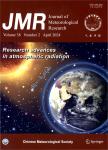First Look of Surface Vegetation from the Advanced Geostationary Radiation Imager(AGRI) onboard Fengyun-4B
作者机构:Nanjing University of Information Science&TechnologyNanjing 210044 National Satellite Meteorological CentreChina Meteorological AdministrationBeijing 100081 Jiangsu Climate CentreJiangsu Provincial Meteorological ServiceNanjing 210009
出 版 物:《气象学报:英文版》 (Journal of Meteorological Research)
年 卷 期:2023年第37卷第4期
页 面:536-550页
核心收录:
学科分类:07[理学] 070601[理学-气象学] 0706[理学-大气科学]
基 金:Supported by the National Key Research and Development Program of China (2021YFB3900400) National Natural Science Foundation of China (U2142212 and U2242211)
主 题:atmospheric correction normalized difference vegetation index(NDVI) spectral response function(SRF) bidirectional reflectance distribution function(BRDF)
摘 要:For many years, the status of surface vegetation has been monitored by using polar-orbiting satellite imagers such as Moderate Resolution Imaging Spectroradiometer(MODIS). However, limited availability of clear-sky samples makes the derived vegetation index dependent on multiple days of observations. High-frequency observations from the geostationary Fengyun(FY) satellites can significantly reduce the influence of clouds on the synthesis of terrestrial normalized difference vegetation index(NDVI). In this study, we derived the land surface vegetation index based on observational data from the Advanced Geostationary Radiation Imager(AGRI) onboard the FY-4B geostationary satellite. First, the AGRI reflectance of visible band and near-infrared band is corrected to the land surface reflectance by the 6S radiative transfer model. The bidirectional reflectance distribution function(BRDF) model is then used to normalize the AGRI surface reflectance at different observation angles and solar geometries, and an angle-independent reflectance is derived. The AGRI surface reflectance is further corrected to the MODIS levels according to the AGRI spectral response function(SRF). Finally, the daily AGRI data are used to synthesize the surface vegetation index. It is shown that the spatial distribution of NDVI images retrieved by single-day AGRI is consistent with that of 16-day MODIS data. At the same time, the dynamic range of the revised NDVI is closer to that of MODIS.



